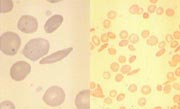Sickle cell anemia
Sickle cell anemia is widespread in the African population.
This hereditary disease is caused by an error in the blueprint for the blood protein hemoglobin. This error leads to deformities in the shape of the red blood cells. These red cells, which are usually round and discoidal, take on the shape of a sickle.
The body breaks down the sickle-shaped blood cells more rapidly than the discoid blood cells. Affected persons thus have less red cells in the blood. Because of this, the term anemia, meaning “lack of blood” is used. If only the deficient hemoglobin is produced, it has fatal consequences. The blood cells are quickly deformed to a sickle shape; they agglutinate and clog small blood vessels. This results in brain damage with symptoms of paralysis and further organ damage.
Luckily, all blueprints for proteins are available twice in the genetic material. For the protein hemoglobin, there are two gene copies as well. Whether the severe or the less grave form of sickle-cell anemia breaks out depends on whether both or only one of the hemoglobin copies have been genetically altered.
If only one of the two copies is deficient, there are no grave consequences for the affected individuals. Since there is still a second gene which has not mutated, some regular hemoglobin can still be produced. Affected individuals only fall ill in the case of an oxygen deficiency.
One great advantage compensates for this disadvantage, and that is the higher resistance against the malaria pathogen.
